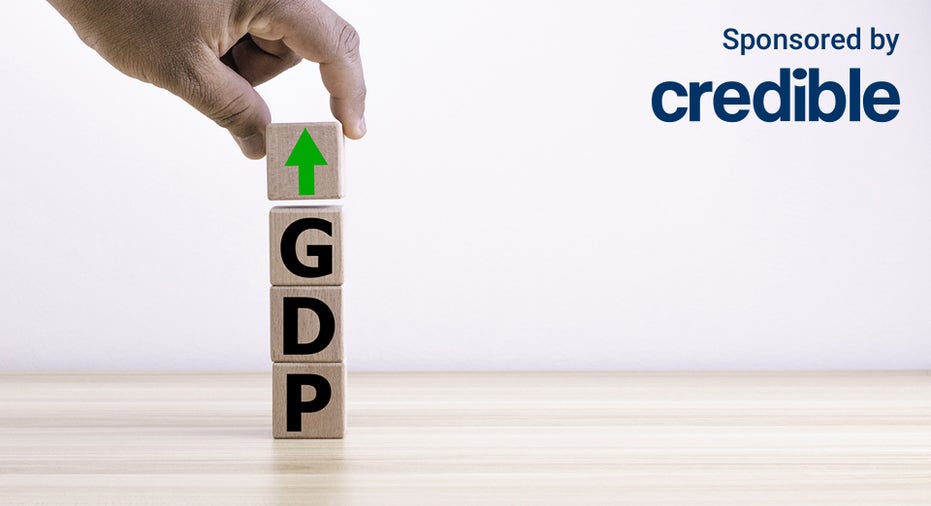GDP registers larger than expected gain in Q2, quieting concerns of a recession
Sticky inflation and strong economic growth support Fed's decision to hike interest rates

Gross domestic product (GDP) came in better than expected for the second quarter and could further bolster the Fed's decision to continue raising interest rates this year, according to one economist. (iStock)
Gross domestic product (GDP) increased in the second quarter of 2023, beating expectations and putting the timeline of a recession further in the distance, according to the Bureau of Economic Analysis (BEA).
Real GDP increased at an annual rate of 2.4% for the April-through-June period, after rising 2% in the first quarter this year, according to the BEA's advance estimate released Thursday. Economic forecasts had called for a 1.8% increase for the second quarter of 2023.
The increase in real GDP was driven by consumer spending, nonresidential fixed investment, state and local government spending, private inventory investment and federal government spending. However, decreases in exports and residential fixed investment offset growth.
Resilience in consumer spending comes as inflation and rising prices prompted the Federal Reserve to raise interest rates 11 times since 2022, bringing the federal funds rate to a targeted range of 5.25% to 5.5%, the highest level in 22 years. It also bucks concerns over the U.S. entering a recession in the second half of 2023, according to the National Association of Federally-Insured Credit Unions (NAFCU).
"A moderate pace of growth affirms the economy had plenty of fuel in the tank to weather a historic combination of rising interest rates and inflation," NAFCU Economist Noah Yosif said in a statement. "The dual-resilience in consumer spending, underpinned by a robust labor market, and business investment, supported by sustained economic activity, enabled the economy to avoid a recession at a time of heightened vulnerability to realizing one.
"A soft-landing remains possible, but timing will be essential to realizing this outcome – balancing a drawdown in the tightening cycle with its constrictive effects on economic growth," Yosif continued.
If you're struggling in the current economy, you could consider paying off high-interest debt with a personal loan at a lower rate. You can visit Credible to get your personalized interest rate without affecting your credit score.
MOST SENIORS REGRET RETIREMENT PLANNING DECISIONS, WANT DO-OVER: SURVEY
Report reveals promising progress on inflation
Inflation, as measured by the personal consumption expenditures (PCE) deflator in the report, eased to 2.6%, a promising sign that it is moving toward the Fed's 2% target, according to Jim Baird, Plante Moran Financial Advisors' chief investment officer.
"Beyond the surprisingly strong top-line growth, measures of inflation embedded in the report were largely positive, confirming previously released data that showed a marked slowdown in year-over-year measures of prices," Baird said. "That's the good news."
The bad news is that core inflation, which, unlike headline inflation, doesn't benefit from declining energy prices, and has been slower to drop toward the Fed's 2% target. This makes a case for future rate hikes, according to Baird.
In June, the 12-month change in the consumer price index (CPI) came in at 3% and core CPI was 4.8%.
"So we would want core inflation to be coming down because that's what we think – core is signaling where headline's going to go in the future," Fed Chairman Jerome Powell told reporters at a press conference on Wednesday. "And core inflation is still pretty elevated. There's reason to think it can come down now, but it's still quite elevated. And so we think we need to stay on task. And we think we're going to need to hold policy at restrictive levels for some time. And we need to be prepared to raise further if that's appropriate."
If you want to take advantage of today's interest rates before they rise further, you could consider refinancing your private student loans to lower your monthly payments. Contact Credible to speak to a student loan expert and see if this is the right option for you.
MAJORITY OF HOMEBUYERS SAY THEY HAVE REGRETS: SURVEY
Housing growth restrained
Growth in the housing market, on the other hand, continues to drag as higher prices and interest rates keep demand restrained, according to Baird.
Mortgage rates have hovered in the 6% to 7% range since the start of the year, and with the Fed's continued restrictive monetary policy, they are unlikely to budge lower.
Higher rates, however, have kept the housing supply low since homeowners, locked into previously low mortgage rates, stayed in their current homes. Listings of existing homes are down 35% as of April 2023, compared to the pre-pandemic average recorded between 2016 and 2019, according to a report by Freddie Mac.
When homes do come up for sale, they are being met with strong demand and are starting to sell above the asking price, according to the May S&P CoreLogic Case-Shiller Indices report.
"New home construction is set to increase in the quarters ahead, but the weakness in the existing home market, which is much larger, means the housing sector as a whole is still subtracting from rather than contributing to overall growth," Mike Fratantoni, Mortgage Bankers Association senior vice president and chief economist, said in a statement.
If you are ready to shop for a mortgage loan or are looking to refinance an existing one, the Credible marketplace can help you compare rates and lenders and get a mortgage preapproval letter in minutes.
COST IS THE BIGGEST FACTOR BEHIND WHY A MAJORITY OF AMERICANS DELAY MEDICAL CARE: SURVEY
Have a finance-related question, but don't know who to ask? Email The Credible Money Expert at moneyexpert@credible.com and your question might be answered by Credible in our Money Expert column.




















